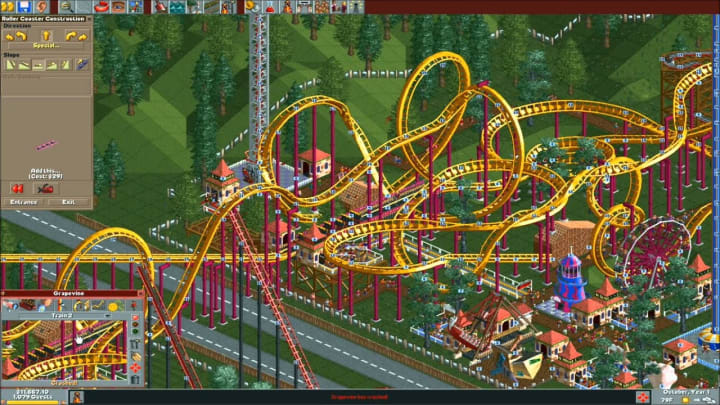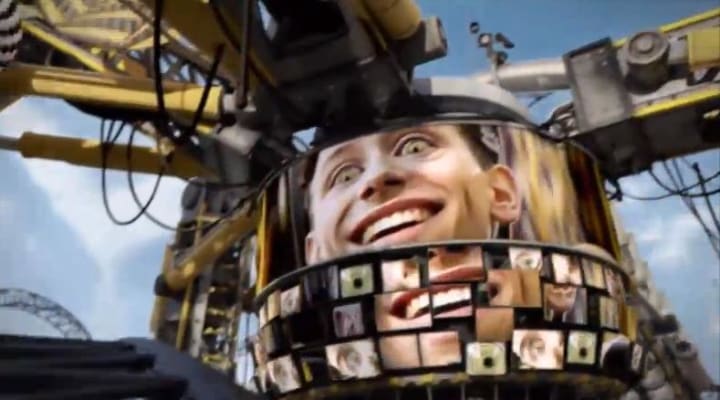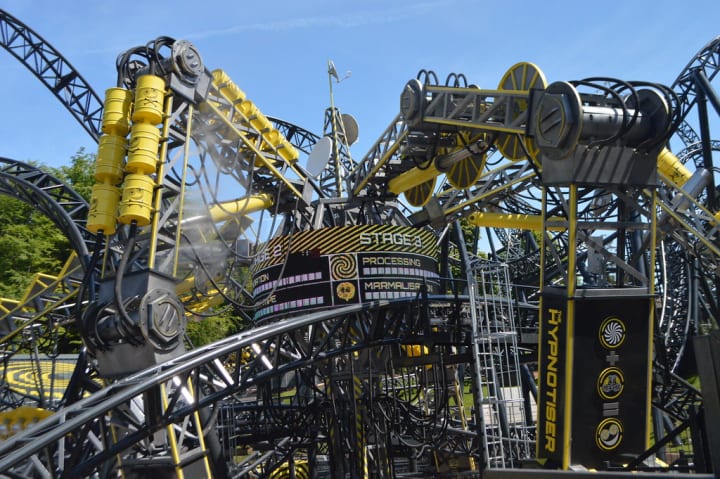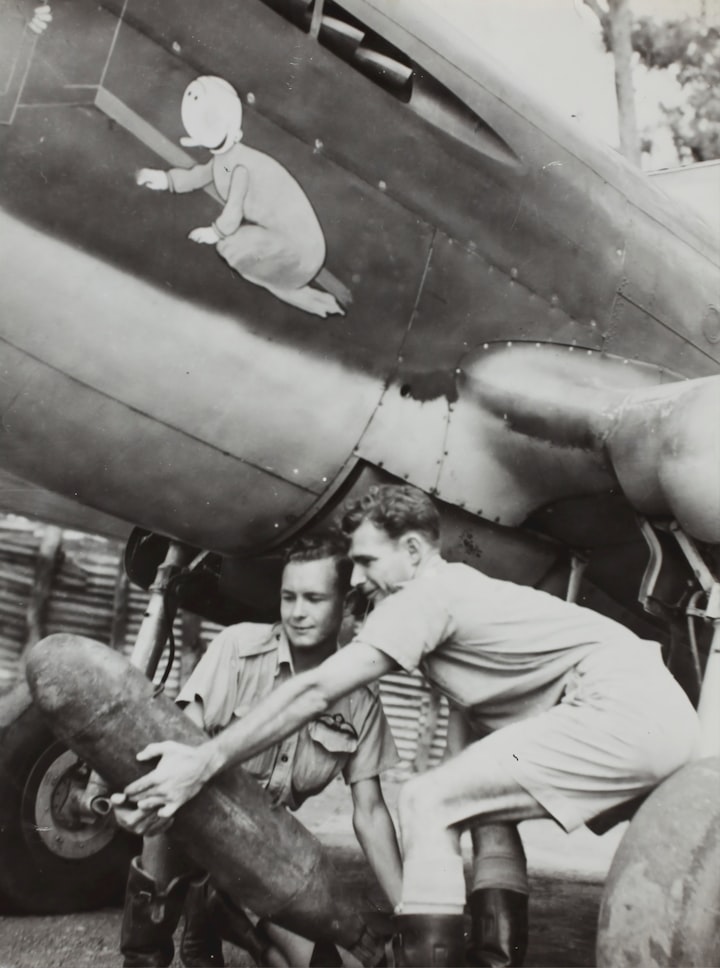What Makes Rollercoasters So Fun?
A look at the science, psychology and design behind rollercoasters - with a focus on 'The Smiler'

I'm standing watching The Smiler at Alton Towers, one of the UK's most popular theme parks.
It's a one-of-a-kind steel rollercoaster which gives off an 'insanity' vibe; after all, the logo isn't a friendly, welcoming smile, but an ecstatic Cheshire cat grin which borders on the psychotic. The soundtrack that is blasting out is overly cheery and somewhat sinister, featuring repetitive, out-of-key chanting along to heavy, distorted beats. Carriages full of Alton Towers guests fly around the inverted track and the enraptured screams emanating from them bounce and curve with every loop.

I'm pointing my phone at a particular part of the track whilst waiting for my friends and partner to come rolling over - I'm filming in slow-mo mode, so that once they get off I can present to them their creasing faces and rippling hair as they are flung forwards at speeds of 85km per hour.
Once I review the footage, one thing is clear: the people on this ride are grinning ear-to-ear. It appears The Smiler does exactly what it says on the tin.
So why am I not on this ride? Put simply, I don't enjoy rides with a high G-force or inversions as much as I used to. I have never been a fan of suspended coasters either due to an experience I had at age 15 (warning: gross) when I embarked on a suspended rollercoaster with several loops and a jet of snot evacuated my nostril as I was thrown about all over the place. Although The Smiler isn't a suspended coaster, my friend warned me that if I thought that Nemesis (Alton Towers's fastest suspended coaster which I went on in 2010) 'was a bit much, you probably won't like this one' - so I decided to sit it out.
I didn't completely refrain from the rollercoasters, though. I still went on Galactica, Wickerman and Th13teen (which I particularly enjoyed). But these will still be considered pretty tame by the most extreme of thrill-seekers.
Rollercoaster Tycoon and real-world physics
Although I'm not crazy about riding intense rollercoasters, I still enjoy learning about what makes certain attractions so popular. I have been an avid Rollercoaster Tycoon fan since the age of 8/9 and on Steam I have racked up over 200 hours of playtime - that equates to over a week of my adult life spent trying to please tiny, whiney 2D theme park guests who all look identical.
Did you know that Rollercoaster Tycoon incorporates real-world physics to a T? When Scottish-born Chris Sawyer designed this game in the 90s, he wasn't messing around - for any coaster you're building, all the specs are there, such as lateral G-force, vertical Gs, inversions, drop height, etc.

In fact, the in-game physics of Rollercoaster Tycoon mirror reality so closely that if you perform a test which rollercoaster engineers use - the 'Brachistochrone Curve' - in the game, you get the same results as you would in reality.
If you want to build a successful rollercoaster in Rollercoaster Tycoon, you have to have some understanding of ride mechanics. For example, knowing how to ensure your ride will produce enough momentum so that a coaster car doesn't get stuck halfway round a loop; knowing how design makes a ride too intense or boring; but most importantly, knowing how to build a coaster that brings in THAT CASH MONEY.

So, how did John Wardley (designer of The Smiler) know it would be such a huge success? What is the science behind The Smiler and why is it so many peoples' favourite Alton Towers attraction?
Using The Smiler, I will examine three essential elements which are considered when constructing a mind-blowing coaster - the physical design of the ride, the way the ride makes guests feel and the theming used.
Let's twist again - Inversions and G-force
The Smiler has a record-breaking 14 inversions, the most of any rollercoaster in the world. Inversions come in a variety of shapes - loops, corkscrews, barrel rolls - and they create an exciting and intense ride when there's only so much building space available. Designer John Wardley said that the engineers “packed more track per meter of space in this ride than any other rollercoaster in the world", which probably explains why The Smiler is also one of the longest-lasting rollercoasters in the world, taking almost 3 minutes to complete a full circuit.

The Smiler also packs a whole lot of G-force thanks to the ride's drops, twists and turns; according to Wikipedia, The Smiler's G-force rating is a nail-biting 4.8 - keep in mind that astronauts experience a G-force of 3.0 during a rocket launch. Also keep in mind that supposedly 5 Gs is the limit a person can usually withstand before passing out. Perhaps this is why people exit The Smiler giddy and grinning like idiots - because the heavy Gs deprived their brains of oxygen.
It is true that depriving your brain of oxygen can produce a sense of euphoria. But then so can the cocktail of chemicals that are released with the twists, turns and undulations of coaster tracks. This is where I'll go into the psychology behind rollercoaster enjoyment.
'Scream if you want to go faster!'

According to a Psychology Lecturer at Keele University, people enjoy rollercoasters "thanks to a combination of speed, conquering fear and the positive effects associated with a massive rise in physiological arousal." Arousal? Oo-er! The only thing that felt aroused for me when looking at The Smiler was my gag reflex. But for others, the 14 inversions boasted by this triumphant bastard hit differently.
For many thrill-seekers, the feeling of anticipation before the main event is the best part. One of the typical staples of almost any rollercoaster - the suspenseful build-up of the chain pulling you to the top of the hill - can be equated to the music before a horror movie jump scare, the wind lashing your face before you skydive, and - dare I say it - the feeling right before you climax. Rollercoasters instill the feelings we get from these very human experiences by using complex engineering and that is what makes them so fascinating. The Smiler uses two vertical lift hills not only for practical purposes but also to rouse these feelings of tense anticipation in guests, before they succumb to the electrifying rush of fight-or-flight endorphins as they drop, spin and loop.

When I asked my friend what she liked about riding The Smiler, she responded with a twinkle in her eye, "It's the danger, isn't it?" - indeed she's right that a lot of us enjoy rollercoasters because we're essentially sticking our middle finger up at the Neanderthal part of our brain which tells us to run a mile when we catch sight of these giant, unnatural structures. Terror and thrill are on the same spectrum, and a theory by psychologists Schachter and Singer states that how we attribute fear can also be very important - some people label the arousal caused by rollercoasters as scary and negative, whereas others find it pleasurable.
The importance of theming

Sure, just a bog-standard rollercoaster which offers high speed, G-force and intensity can be exciting, but if you incorporate a theme or story as part of the attraction it gives the experience so much more character.
Part of the reason why 2 million guests flock to Alton Towers every year is because of designers' abilities to give a believable narrative to their rides. TH13TEEN takes you on a journey through a crypt hidden in a dark forest; the track of Nemesis supposedly extends from an other-worldly lobster monster; the list goes on.
I already outlined some of The Smiler's 'insanity' theming at the beginning of this article. This is a result of the ride's narrative which is based on the fictional story of Dr Kelman, a maniacal medic and head of 'The Ministry of Joy'. The Ministry of Joy is a secret government organisation whose purpose is to increase 'social satisfaction' amongst the masses, and this is where the concept of The Smiler comes from. The Smiler was invented to 'leave a permanent smile on peoples' faces' with the help of a machine named 'The Marmaliser' which sits at the centre of the ride.

The Marmaliser makes the experience that bit more twisted - as the riders pass under each of the 5 'legs' of this machine, they encounter a device designed to make them forcibly smile:
- The Inoculator - giant hypodermic needles which inject you with a 'jab of happiness'
- The Tickler - rotating bristles which tickle you
- The Hypnotizer - huge spinning wheels which mesmerise you
- The Flasher - strobe lights which disorientate
- The Giggler - a device which releases laughing gas

Obviously, these are just props and those on the ride don't actually get poked, prodded and gassed - The Marmaliser does however immerse guests in this terrifying story of government control and leave riders truly believing they've been a subject of Dr Kelman's experiments. As the tagline goes, "You Belong To The Smiler".
As mentioned at the beginning of the article, the logo also adds to the theme of insanity and institutionalization through its maniacal smile, and the repetitive, chanting soundtrack makes you feel like you're losing your marbles as it gets stuck in your head for weeks - it definitely won't leave my brain ever since my Alton Towers visit. To subject yourself to this madness, listen to the link below:
Overall, in the case of The Smiler, it is clear that its record-breaking, endorphin-triggering design, along with its captivating backstory and theme, all work in harmony to produce an exemplary rollercoaster and an unforgettable experience for anyone who rides. Hell, I didn't even go on it, and I still enjoyed it - I think I may have to give it a try next time I'm at Alton Towers.
About the Creator
Dee Simone
I like to write, create, pet kitties, listen to owls, talk about life, watch indie films, laugh, make new friends 😊🐌🌻💋👾🧠⚡️🪐
✍️ www.medium.com/indiefilmsdee
📷 www.instagram.com/indiefilmsdee
🐦 www.twitter.com/indiefilmsdee






Comments
There are no comments for this story
Be the first to respond and start the conversation.